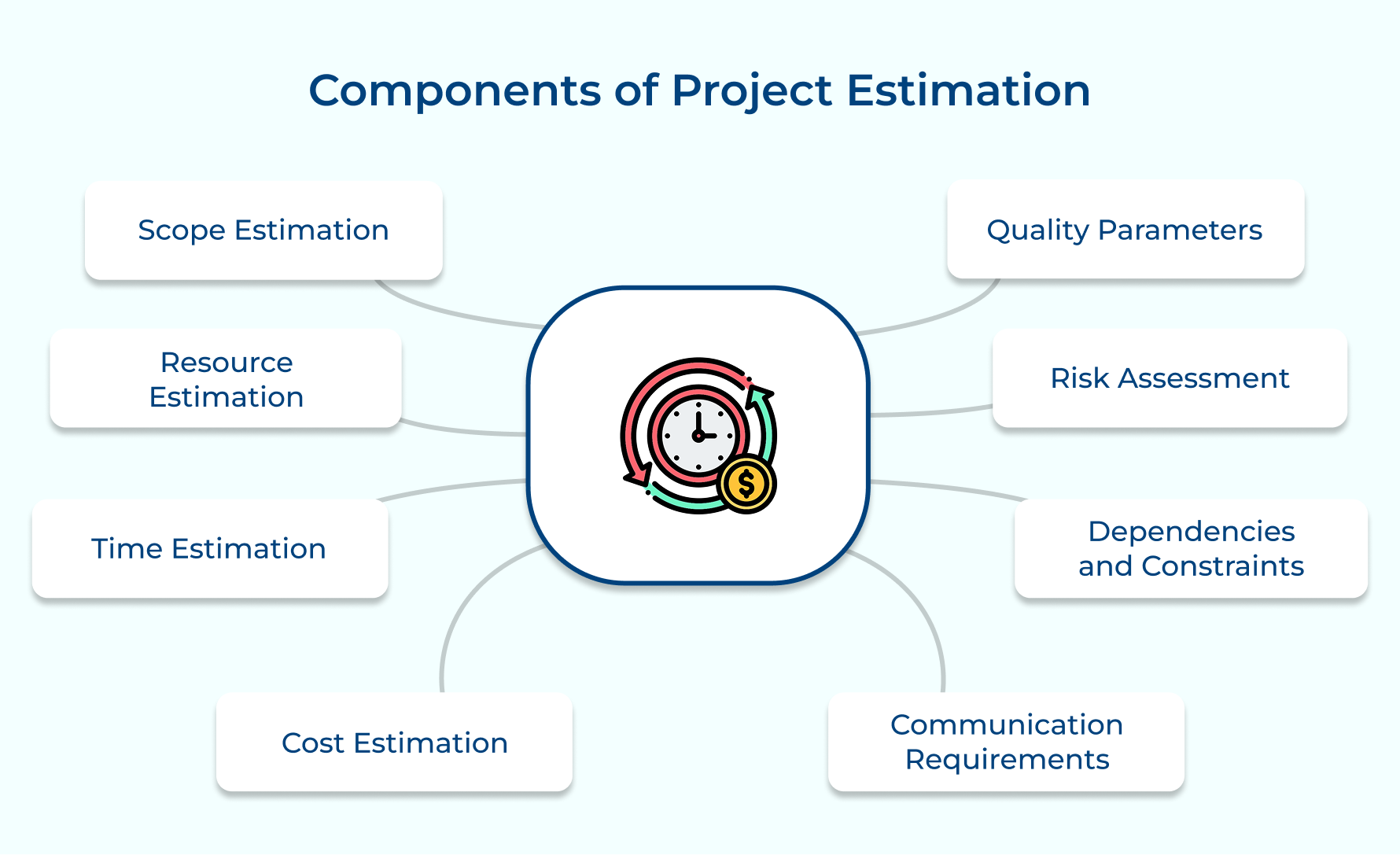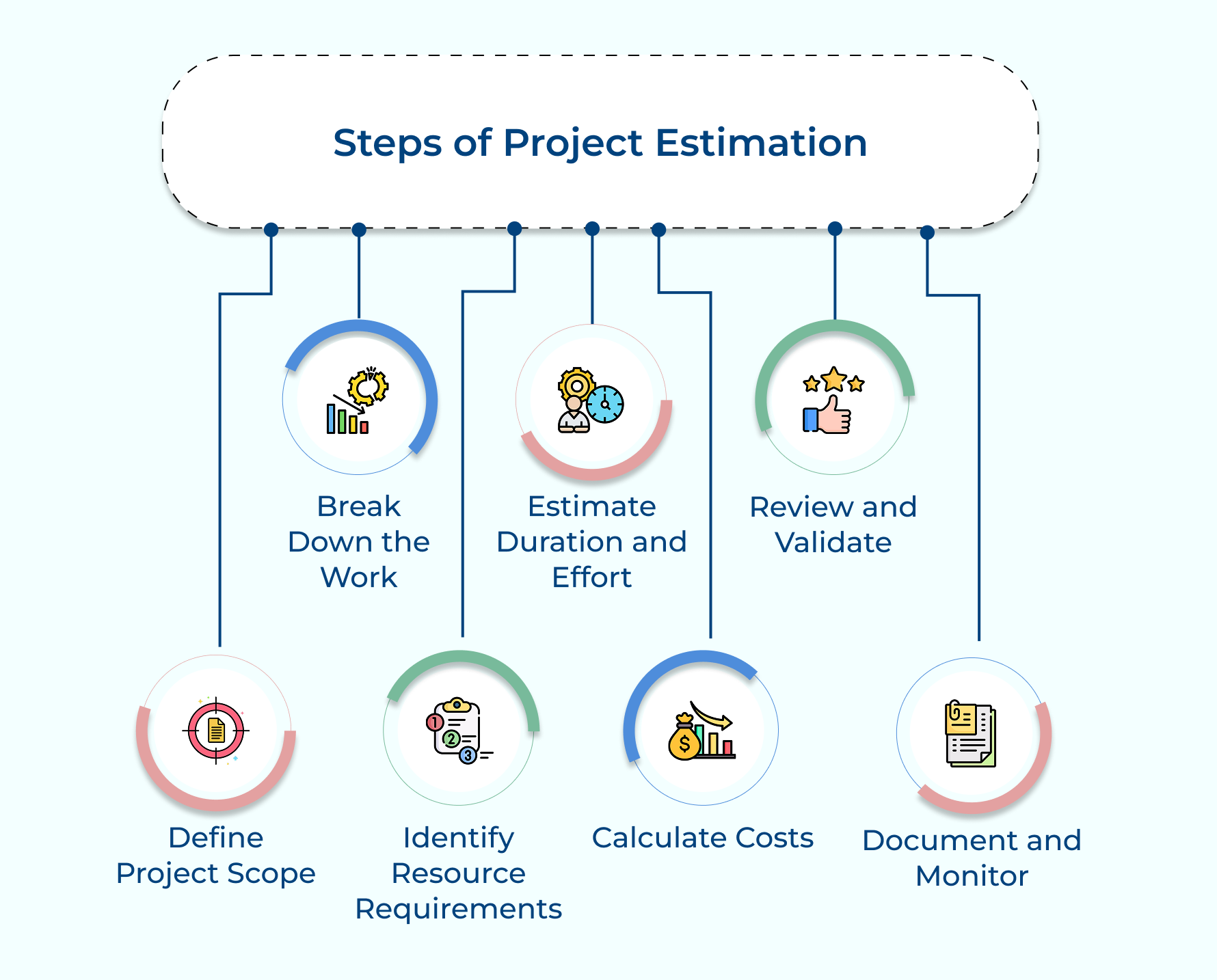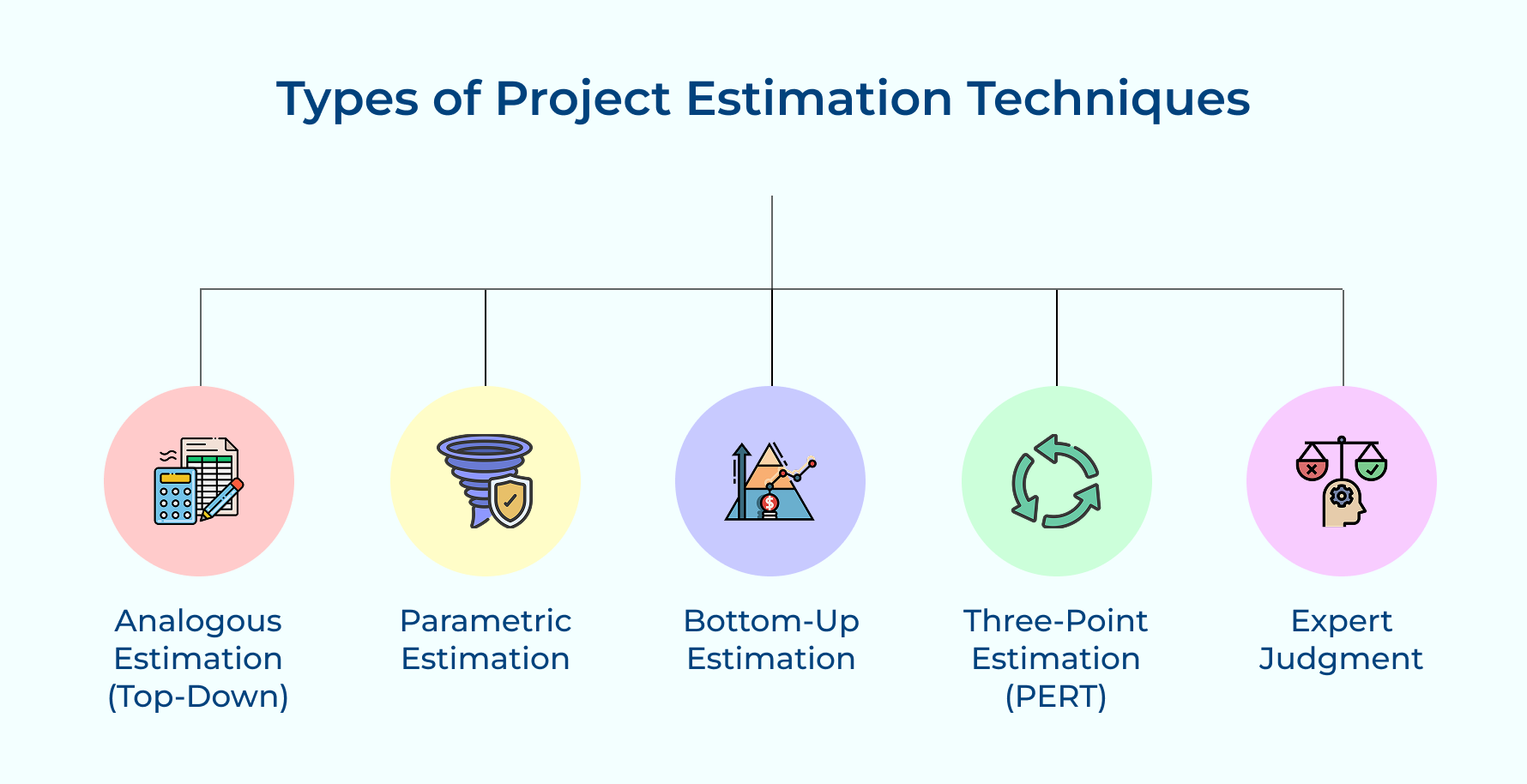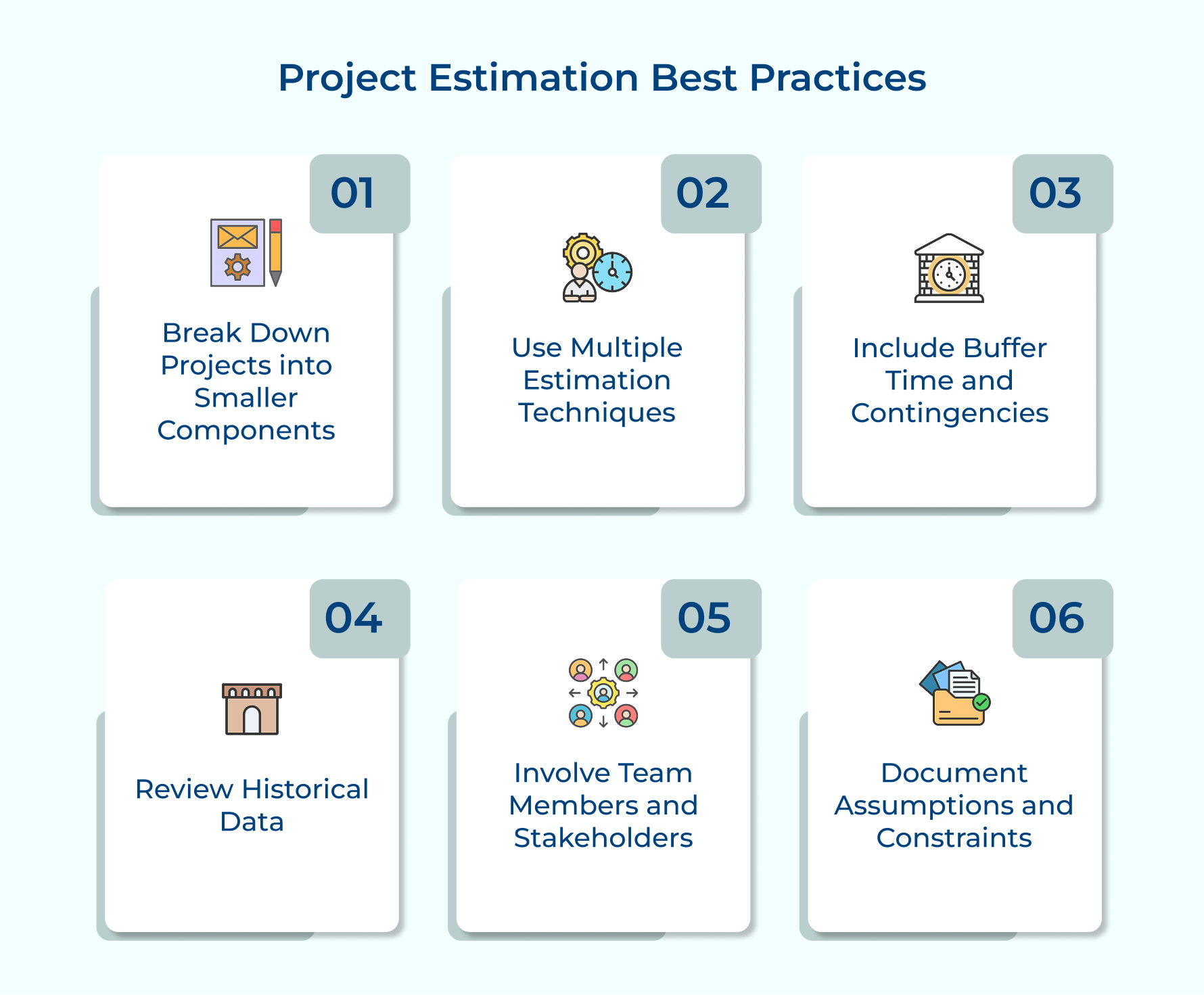How to Calculate Project Estimation in 7 Easy Steps

Key Highlights:
- Accurate project estimation ensures realistic timelines, budgets, and resource allocation, preventing unexpected delays for smooth project execution.
- Using techniques like bottom-up estimation, three-point analysis, and expert judgment improves accuracy while also enhancing decision-making.
- Regularly reviewing estimates and involving stakeholders help refine projections, ensuring projects stay aligned with goals.
Project teams often struggle with delays, budget overruns, and unexpected roadblocks—all thanks to inaccurate project estimation. Without a clear understanding of the resources and costs needed, the project schedule can quickly go off track.
When estimates are off, individual tasks take longer than expected, budgets spiral out of control, and teams feel overwhelmed. Stakeholders lose confidence, and everyone is stuck reacting to problems just to keep the entire project afloat.
But with accurate project estimation, teams can forecast time, costs, and resources effectively. This sets a clear direction, keeps the project schedule on track, prevents common pitfalls, and ensures smoother execution. Let’s explore more about how to estimate.
What is Project Estimation?
Project estimation is the process of predicting the time, resources, cost, and effort required to complete a project. It involves determining the scope, duration, and costs involved in a project as well as creating a plan to guide the project from initiation to completion.
Accurate estimation provides stakeholders with a realistic view of what is required to complete a project. It helps in risk management by identifying potential challenges and developing mitigation strategies.
Key objectives:
- Resource planning: Determine the precise quantity and type of resources needed, including human resources, materials, equipment, as well as technology required for project completion.
- Financial management: Establish accurate budget forecasts to secure appropriate funding and ensure optimal allocation of financial resources throughout the project lifecycle.
- Timeline development: Create realistic schedules that account for task dependencies, potential delays, and resource availability to ensure timely project delivery.
Key Components of Project Estimation
Accurate project estimation relies on key components that shape the project schedule, resource allocation, and budgeting. Here’s what project teams need to get it right.
Scope Estimation
Before diving into timelines and budgets, project teams need a clear understanding of what’s included. Scope estimation sets the foundation by defining project boundaries, deliverables, and requirements. Breaking down work into individual tasks and work packages helps avoid scope creep as well as keeps everything on track.
Resource Estimation
Every project depends on the right mix of people, tools, and materials. Project stakeholders, as well as subject matter experts, must assess team size, required skills, equipment, and infrastructure. Proper resource planning ensures smooth execution without overloading the team.
Time Estimation
How long will each project task take? Time estimation looks at dependencies, constraints, and risks to create a realistic project schedule. Using techniques like critical path analysis and team velocity tracking helps prevent delays along with bottlenecks.
Cost Estimation
Project costs can quickly spiral out of control without accurate budgeting. Teams must account for direct costs (labor, materials, equipment), indirect costs (overhead, facilities), and additional expenses like training or consultancy fees. Setting aside contingency reserves ensures that unexpected changes don’t derail the budget.
Quality Parameters
Deliverables must meet specific quality standards. Testing, validation, and quality assurance activities should be factored into both time as well as cost estimates. This ensures the final output meets expectations without last-minute surprises.
Risk Assessment
No project is risk-free. Identifying potential risks early helps teams plan mitigation strategies and allocate appropriate contingency reserves. Quantifying risk probability and impact prevents costly surprises down the line.
Dependencies and Constraints
Projects don’t exist in isolation. Internal and external factors—like technical requirements, resource limitations, regulatory policies, along with organizational goals—impact execution. Understanding these constraints helps teams create achievable estimates.
Communication Requirements
Clear communication is key to keeping everyone aligned. Meetings, reports, stakeholder updates, and presentations take time as well as resources. Planning for these activities ensures smooth collaboration without disrupting workflows.
How to do Project Estimation: 7 Steps
Project estimation isn’t just about guessing numbers, it’s about creating a realistic plan. Follow these seven steps to estimate project tasks and timelines effectively.
Define Project Scope
Getting the project scope right is crucial for accurate estimation. Here’s how to do it effectively:
- Set clear boundaries: Define what’s included (and what’s not) to prevent scope creep.
- Align with stakeholders: Ensure project stakeholders agree on deliverables, features, and success criteria.
- Avoid misunderstandings: A well-defined scope eliminates confusion and unrealistic expectations.
- Gather requirements: Conduct stakeholder interviews, review documents, and list out all project needs.
- Create a scope statement: Outline inclusions, exclusions, constraints, and assumptions in a structured document.
- Use as a reference: Keep the scope statement handy for all project estimation and planning activities.
Tips:
- Hold structured workshops with all key stakeholders to capture requirements and get immediate clarification on ambiguous points.
- Create a scope verification checklist and get a formal sign-off from stakeholders before proceeding with a detailed estimation.
Break Down the Work
A Work Breakdown Structure (WBS) makes project estimation easier by dividing deliverables into smaller, manageable tasks. How it helps:
- Simplifies complex projects: Breaking work into smaller units makes it easier to estimate, schedule, and track.
- Reveals hidden tasks: Identifies smaller tasks that might otherwise be overlooked.
- Improves accuracy: Smaller, well-defined work packages lead to more precise estimates.
- Considers project constraints: Helps assess time, resources, and dependencies within project limitations.
- Create a clear structure: Start with major deliverables and break them into detailed work packages.
- Supports better planning: Use the WBS to allocate resources, manage dependencies, and identify risks.
Tips to consider:
- Ensure work packages are small enough to be estimated accurately (typically no longer than 2 weeks of effort).
- Use standardized templates and previous project WBS structures as reference points for similar projects.
Identify Resource Requirements
Resource identification means figuring out what’s required (if it’s skilled team members, equipment, software, or materials) to complete each task and the entire project. This step helps avoid resource shortages, conflicts, or last-minute surprises.
By mapping skills and resources to specific tasks, you can estimate project costs more accurately, as well as spot potential bottlenecks early. Checking resource availability, productivity levels, and work schedules ensures smooth execution. A resource loading chart can help visualize how resources are distributed across the project timeline, making planning much more efficient.
Pro tips:
- Maintain a skills inventory matrix to match available resources with project needs efficiently.
- Factor in resource productivity rates based on historical data and experience levels.
Estimate Duration and Effort
Figuring out how long tasks will take and how much effort they require is key to keeping your project on track. Imagine you’re planning a website launch. You need to estimate how much time developers will need to code the site, how long designers will take to finalize visuals, and when the content team can deliver a copy.
To get accurate estimates, use different techniques like three-point estimation (best-case, worst-case, and most likely scenarios), expert advice from subject matter experts, or parametric modeling (using past project data for reference).
Consider task complexity, team experience, and dependencies to avoid underestimating efforts. Realistic time estimates help set achievable deadlines, allocate resources efficiently, and keep the project moving smoothly.
Actionable tips:
- Use the PERT formula (Optimistic + 4x Most Likely + Pessimistic)/6 for better accuracy in uncertain situations.
- Track actual vs. estimated times to improve future estimation accuracy and identify patterns.
Calculate Costs
Getting the project budget right means understanding all costs involved—from team salaries to materials and unexpected expenses. Here’s how to estimate costs effectively:
- Use bottom-up estimating – Break the project into small tasks, estimate costs for each, and sum them up for an accurate total. This works well for detailed budgeting.
- Try analogous estimating – Look at past similar projects to predict costs. This is useful when you have limited details but need a rough estimate.
- Consider the top-down approach – Start with a total budget and allocate costs to different project components based on priority as well as past experiences.
- Convert effort into costs – Multiply work hours by resource rates, add material expenses, overhead, and operational costs.
- Include contingency reserves – Factor in extra funds for risks and uncertainties based on historical data along with project constraints.
Tips to consider:
- Create a standardized cost calculation template that includes all potential cost categories.
- Review cost estimates with finance teams to ensure alignment with organizational budgeting practices.
Review and Validate
Review/validation involves examining estimates for accuracy, completeness, as well as reasonableness through peer reviews and comparison with historical data.
Validation helps identify errors, omissions, or unrealistic assumptions in estimates. It provides confidence in estimation accuracy and helps gain stakeholder buy-in for project plans.
Organize structured review sessions with experienced team members. Compare estimates with similar past projects and industry benchmarks. Document review findings and adjustment rationale.
Pro tips:
- Use a standardized review checklist to ensure consistent evaluation of all estimation aspects.
- Maintain a database of historical estimates and actuals for reference in future validations.
Document and Monitor
Documenting and monitoring your project estimates are key to staying on course. By keeping a clear record of all your estimation details—like the methods, assumptions, and calculations—you ensure everything is transparent and traceable.
Regularly tracking your progress against these estimates helps spot any discrepancies early on so you can make adjustments as needed.
Set up regular check-ins to compare actual performance with your initial forecasts, and keep tweaking your plans to stay aligned with the project’s goals. This way, you stay in control and can address issues before they become bigger problems.
Actionable tips:
- Implement a version control system for estimation documents to track changes and adjustments over time.
- Set up automated tracking systems to collect actual data for comparison with estimates.
Types of Project Estimation Techniques
Project estimation techniques can be broadly categorized into several key approaches, each serving different project needs and contexts. Let’s explore the primary estimation techniques used in project management:
Analogous Estimation (Top-Down)
The top-down estimation uses historical data and past similar projects as a reference point for estimating current project requirements. It’s particularly useful when detailed information about the new project is limited. For example, if a previous website development project took six months, a similar project might be estimated to take approximately the same time, adjusted for complexity differences.
Parametric Estimation
The parametric method uses statistical relationships and historical data metrics to calculate estimates. It’s highly accurate when historical data is reliable. For instance, if building one software module typically requires 100 hours, a project with five similar modules might be estimated at 500 hours, accounting for complexity factors and scale.
Bottom-Up Estimation
The bottom-up approach breaks down the project into smaller components and estimates each separately before combining them for a total estimate. While time-consuming, it typically provides the most accurate results. Project managers decompose tasks into work packages, estimate each package individually, and sum them up for the final estimate.
Three-Point Estimation (PERT)
The technique uses three scenarios: optimistic, most likely, and pessimistic estimates. The final estimate is calculated using a weighted average: (Optimistic + 4x Most Likely + Pessimistic) ÷ 6. This approach helps account for uncertainty and provides more realistic estimates.
Expert Judgment
The method relies on experienced professionals’ knowledge and intuition to make estimates. It’s particularly valuable when dealing with unique or complex projects where historical data might not be applicable. Experts draw from their experience to provide informed estimates while considering project-specific factors.
Best Practices for Effective Project Estimation
Accurate project estimation is key to staying on schedule and within budget. By following best practices, project teams can minimize risks and improve decision-making.
Break Down Projects into Smaller Components
Big projects can feel overwhelming, so break them down into smaller, manageable tasks. A Work Breakdown Structure (WBS) helps ensure nothing gets missed and makes estimation easier. Smaller tasks are simpler to evaluate, leading to more accurate project planning.
Use Multiple Estimation Techniques
Don’t put all your eggs in one basket! Use a mix of estimation methods like expert judgment, parametric estimation, and analogous estimation. Comparing different approaches helps spot inconsistencies and ensures well-rounded estimates.
Include Buffer Time and Contingencies
No project goes exactly as planned, so always allow some buffer time and extra budget for unexpected hiccups. Just make sure the buffer is reasonable—too much padding can make estimates unrealistic, while too little can cause last-minute stress.
Review Historical Data
Past projects hold a wealth of insights! Look at similar projects to see how estimates compare to actual results. Learning from past experiences helps fine-tune your current estimates and avoid repeating mistakes.
Involve Team Members and Stakeholders
The best estimates come from the people doing the work. Get your team involved—they know how long tasks take in real-world scenarios. Also, loop in stakeholders early to align expectations and consider any project constraints.
Document Assumptions and Constraints
Be clear about what’s influencing your estimates. If it’s about resource availability, technical limitations, or external dependencies, document everything. It keeps everyone on the same page and prevents surprises down the road.
Achieving Success Through Accurate Project Estimation
Wrapping up, accurate project estimation is the backbone of successful execution. When you have a clear picture of time, budget, and resources, staying on track becomes much easier, reducing last-minute surprises. Good estimates enable better planning, smarter decision-making, and smoother workflows.
If it’s a small task or a large-scale project, well-calculated estimates ensure that everything runs seamlessly. By using reliable estimation techniques and involving key stakeholders, you can set realistic expectations as well as drive project success. In the end, precise estimates lead to better outcomes and happier teams.
Limit time — not creativity
Everything you need for customer support, marketing & sales.
Neeti Singh is a passionate content writer at Kooper, where he transforms complex concepts into clear, engaging and actionable content. With a keen eye for detail and a love for technology, Tushar Joshi crafts blog posts, guides and articles that help readers navigate the fast-evolving world of software solutions.



